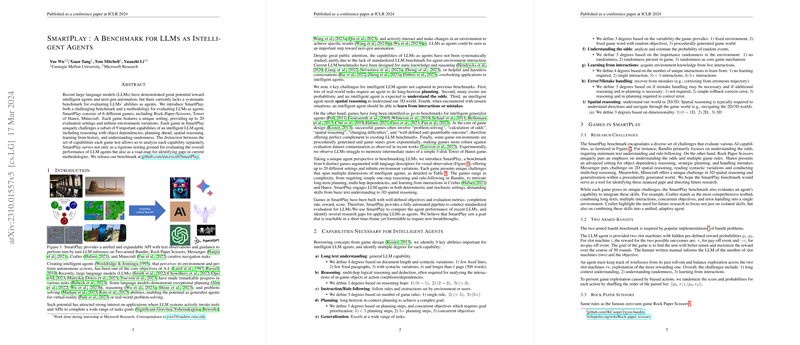SmartPlay: A Comprehensive Benchmark for Assessing LLM Capabilities as Intelligent Agents
The paper "SmartPlay: A Benchmark for LLMs as Intelligent Agents," presents a seminal effort to evaluate the capabilities of LLMs for functioning as intelligent agents. Despite recent advances in LLMs, a standardized benchmark to assess their interaction with dynamic environments and decision-making processes in agent-based settings has been lacking. This work addresses this gap by introducing "SmartPlay", a suite of tests designed to evaluate LLMs across a diverse array of capabilities using game-based scenarios.
Summary and Contributions
SmartPlay is a meticulously structured benchmark involving six games — Two-Armed Bandits, Rock Paper Scissors, Tower of Hanoi, Messenger, Crafter, and Minecraft. Each game is selected to challenge specific aspects of LLM capabilities, including reasoning, planning, spatial reasoning, learning from history, and understanding of randomness. The games represent varied complexities, from simple probabilistic reasoning tasks in Two-Armed Bandits to complex 3D spatial reasoning challenges in Minecraft.
A major contribution of the paper is the structured capability analysis. It delineates nine key abilities crucial for intelligent agents and assigns a degree of challenge each game presents to these abilities. For example, Rock Paper Scissors emphasizes understanding the odds, while Messenger stresses on spatial reasoning and syntax variation comprehension. This granularity allows for a detailed assessment of LLMs' strengths and limitations.
The paper provides a comprehensive evaluation of various LLMs, including GPT-4 variants, text-davinci-003, Claude, Bard, and open-source models like LLaMA. The results underscore significant performance disparities between models, particularly highlighting the superior performance of GPT-4 variants. However, even state-of-the-art LLMs show substantial gaps in planning and spatial reasoning capabilities when compared to human baselines.
Implications and Future Directions
The introduction of SmartPlay has profound implications for future AI research. It provides a standardized approach to evaluate and improve the agentive capabilities of LLMs, which could accelerate their deployment in real-world applications requiring interactive decision-making. The benchmark identifies current gaps in LLMs, such as challenges in learning from interactions and executing long-horizon planning, thus directing future research towards these areas.
SmartPlay also contributes to robustness in evaluation by using games with procedurally generated environments, minimizing issues of data contamination found in static datasets. This supports fair assessments of LLM generalization capabilities, especially in complex environments like Minecraft.
In terms of future development, SmartPlay offers a flexible framework for incorporating additional games, allowing it to evolve alongside advancements in AI. Researchers should anticipate expanding SmartPlay further to include newer AI models and elaborate on capabilities like error correction and contextual adaptability, vital for next-gen automation.
Conclusion
This paper establishes SmartPlay as a rigorous, multifaceted benchmark for evaluating LLMs as intelligent agents. By leveraging the interactive nature of games, it provides a thorough investigation into crucial areas of LLM functionalities, notably planning, spatial reasoning, and interaction-based learning. The findings not only reveal current model limitations but also chart a path for future innovations in the field of autonomous intelligent agents, enhancing the applicability of LLMs across diverse sectors of AI-driven automation.
